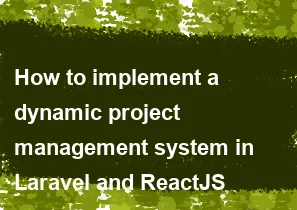How to implement a dynamic project management system in Laravel and ReactJS

Implementing a dynamic project management system using Laravel for the backend and ReactJS for the frontend involves several steps. Here's a high-level guide to get you started:
Backend (Laravel):
Setup Laravel Project:
- Install Laravel using Composer.
bashcomposer create-project --prefer-dist laravel/laravel project-management-systemDatabase Setup:
- Configure your database credentials in the
.envfile. - Run migrations to create necessary tables.
bashphp artisan migrate- Configure your database credentials in the
Create Models:
- Create models for entities like
Project,Task,User, etc.
bashphp artisan make:model Project -m- Create models for entities like
Define Relationships:
- Define relationships between models in their respective files.
API Routes:
- Create API routes in
routes/api.phpfor CRUD operations on projects, tasks, etc.
phpRoute::apiResource('projects', 'ProjectController');- Create API routes in
Controllers:
- Create controllers to handle CRUD operations for projects, tasks, etc.
bashphp artisan make:controller ProjectControllerResource Classes:
- Create resource classes to format data before sending it to the frontend.
bashphp artisan make:resource ProjectResourceAuthentication:
- Implement user authentication using Laravel's built-in auth system.
bashphp artisan make:auth
Frontend (ReactJS):
Setup React App:
- Create a new React app using Create React App or any other method you prefer.
bashnpx create-react-app project-management-frontendFolder Structure:
- Organize your React project structure. For example:csssrc/ components/ pages/ services/
- Organize your React project structure. For example:
API Calls:
- Create service functions in the
servicesdirectory to make API calls usingfetchor a library like Axios. - Handle CRUD operations for projects, tasks, etc.
- Create service functions in the
State Management:
- Use state management tools like React Context or Redux to manage the state of your application.
Routing:
- Implement routing using React Router to navigate between different pages of your project.
Forms and UI Components:
- Design and implement forms for adding/editing projects, tasks, etc.
- Create reusable UI components for a consistent look and feel.
Authentication Integration:
- Integrate authentication with the Laravel backend using tokens or sessions.
Real-time Updates (Optional):
- Implement real-time updates using technologies like WebSockets or Pusher for a dynamic experience.
Connect Frontend and Backend:
API Base URL:
- Set up a configuration file or environment variable for the API base URL.
Make API Calls:
- Use the API base URL in your service functions when making API calls.
Authentication:
- Send authentication tokens with your API requests.
Handle Responses:
- Handle API responses appropriately, updating the UI based on success or error.
Testing:
Unit Tests:
- Write unit tests for backend controllers, models, and frontend components.
Integration Tests:
- Test the integration between the frontend and backend.
Deployment:
Backend:
- Deploy your Laravel backend to a server, ensuring the database and environment settings are correctly configured.
Frontend:
- Build your React app and deploy it to a static file server or integrate it with a backend server.
Remember to adapt these steps based on the specific requirements and features of your project management system. Additionally, consider using tools like Laravel Passport for API authentication and Laravel Echo or Pusher for real-time updates if needed.
-
Popular Post
- How to optimize for Google's About This Result feature for local businesses
- How to implement multi-language support in an Express.js application
- How to handle and optimize for changes in mobile search behavior
- How to handle CORS in a Node.js application
- How to use Vue.js with a UI framework (e.g., Vuetify, Element UI)
- How to configure Laravel Telescope for monitoring and profiling API requests
- How to create a command-line tool using the Commander.js library in Node.js
- How to implement code splitting in a React.js application
- How to use the AWS SDK for Node.js to interact with various AWS services
- How to use the Node.js Stream API for efficient data processing
- How to implement a cookie parser middleware in Node.js
- How to implement WebSockets for real-time communication in React
-
Latest Post
- How to implement a dynamic form with dynamic field styling based on user input in Next.js
- How to create a custom hook for handling user interactions with the browser's device motion in Next.js
- How to create a custom hook for handling user interactions with the browser's battery status in Next.js
- How to implement a dynamic form with dynamic field visibility based on user input in Next.js
- How to implement a dynamic form with real-time collaboration features in Next.js
- How to create a custom hook for handling user interactions with the browser's media devices in Next.js
- How to use the useSWRInfinite hook for paginating data with a custom loading indicator in Next.js
- How to create a custom hook for handling user interactions with the browser's network status in Next.js
- How to create a custom hook for handling user interactions with the browser's location in Next.js
- How to implement a dynamic form with multi-language support in Next.js
- How to create a custom hook for handling user interactions with the browser's ambient light sensor in Next.js
- How to use the useHover hook for creating interactive image zoom effects in Next.js